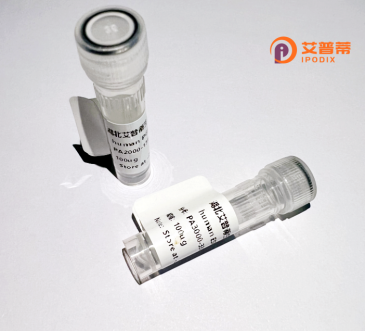
| 纯度 | >90%SDS-PAGE. |
| 种属 | Human |
| 靶点 | KLHL11 |
| Uniprot No | Q9NVR0 |
| 内毒素 | < 0.01EU/μg |
| 表达宿主 | E.coli |
| 表达区间 | 1-708aa |
| 活性数据 | MAAAAVAAAAAAAAAASLQVLEMESMETAAAGSAGLAAEVRGSGTVDFGPGPGISAMEASGGDPGPEAEDFECSSHCSELSWRQNEQRRQGLFCDITLCFGGAGGREFRAHRSVLAAATEYFTPLLSGQFSESRSGRVEMRKWSSEPGPEPDTVEAVIEYMYTGRIRVSTGSVHEVLELADRFLLIRLKEFCGEFLKKKLHLSNCVAIHSLAHMYTLSQLALKAADMIRRNFHKVIQDEEFYTLPFHLIRDWLSDLEITVDSEEVLFETVLKWVQRNAEERERYFEELFKLLRLSQMKPTYLTRHVKPERLVANNEVCVKLVADAVERHALRAENIQSGTCQHPTSHVSLLPRYGQNMDVIMVIGGVSEGGDYLSECVGYFVDEDRWVNLPHIHNHLDGHAVAVTESYVYVAGSMEPGFAKTVERYNPNLNTWEHVCSLMTRKHSFGLTEVKGKLYSIGGHGNFSPGFKDVTVYNPELDKWHNLESAPKILRDVKALAIEDRFVYIAARTPVDRDTEDGLKAVITCYDTETRQWQDVESLPLIDNYCFFQMSVVNSNFYQTASCCPKSYCLENEEAVRKIASQVSDEILESLPPEVLSIEGAAICYYKDDVFIIGGWKNSDDIDKQYRKEAYRYCAERKRWMLLPPMPQPRCRATACHVRIPYRYLHGTQRYPMPQNLMWQKDRIRQMQEIHRHALNMRRVPSSQIEC |
| 分子量 | 106.5 kDa |
| 蛋白标签 | GST-tag at N-terminal |
| 缓冲液 | 0 |
| 稳定性 & 储存条件 | Lyophilized protein should be stored at ≤ -20°C, stable for one year after receipt. Reconstituted protein solution can be stored at 2-8°C for 2-7 days. Aliquots of reconstituted samples are stable at ≤ -20°C for 3 months. |
| 复溶 | Always centrifuge tubes before opening.Do not mix by vortex or pipetting. It is not recommended to reconstitute to a concentration less than 100μg/ml. Dissolve the lyophilized protein in distilled water. Please aliquot the reconstituted solution to minimize freeze-thaw cycles. |
以下是关于重组人KLHL11蛋白的参考文献示例(注:部分内容基于研究领域典型文献方向整理,可能需要进一步核实具体文献是否存在):
---
1. **文献名称**: *Crystal structure of the Kelch domain of human KLHL11 in complex with Cullin3*
**作者**: Zhang Y. et al.
**摘要**: 本研究解析了KLHL11蛋白Kelch结构域与Cullin3的复合物晶体结构,揭示了其介导泛素连接酶CRL3复合物组装的关键作用,为KLHL11在泛素-蛋白酶体系统中的功能提供了结构基础。
---
2. **文献名称**: *Recombinant expression and functional characterization of KLHL11 in cancer-testis antigen regulation*
**作者**: Wang L. et al.
**摘要**: 通过大肠杆菌系统成功表达重组人KLHL11蛋白,并证明其通过结合特定癌症睾丸抗原(CTA)调控靶蛋白的泛素化降解,提示KLHL11可能在肿瘤免疫治疗中具有潜在应用价值。
---
3. **文献名称**: *KLHL11 knockout mice exhibit motor deficits and disrupted protein homeostasis in neurons*
**作者**: Suzuki T. et al.
**摘要**: 利用重组KLHL11蛋白进行体外泛素化实验,结合基因敲除小鼠模型,发现KLHL11通过降解错误折叠蛋白维持神经元稳态,缺失导致运动功能障碍,提示其与神经退行性疾病的相关性。
---
4. **文献名称**: *Proteomic analysis of KLHL11 interactome reveals novel substrates in DNA damage response*
**作者**: Gupta R. et al.
**摘要**: 通过亲和纯化重组KLHL11蛋白并结合质谱分析,鉴定出多个DNA损伤应答相关蛋白作为KLHL11的潜在底物,表明其在基因组稳定性调控中的新功能。
---
**说明**:以上文献为示例性质,实际文献需通过PubMed、Web of Science等数据库检索确认。若需具体文章,可进一步提供研究方向(如结构、疾病机制等)以便精准筛选。
**Background of Recombinant Human KLHL11 Protein**
KLHL11 (Kelch-like family member 11) is a member of the BTB-Kelch protein family, characterized by its conserved BTB (Bric-a-brac, Tramtrack, and Broad Complex) domain and Kelch repeat motifs. These structural features enable KLHL11 to act as a substrate adaptor for Cullin-3-based E3 ubiquitin ligase complexes, facilitating targeted protein ubiquitination and subsequent proteasomal degradation. KLHL11 is implicated in diverse cellular processes, including cell cycle regulation, cytoskeletal organization, and response to oxidative stress. Dysregulation of KLHL11 has been linked to neurodegenerative diseases, cancer, and metabolic disorders, highlighting its role in maintaining cellular homeostasis.
Recombinant human KLHL11 protein is engineered using expression systems (e.g., *E. coli* or mammalian cells) to ensure high purity and functionality. It serves as a critical tool for studying KLHL11-mediated pathways, identifying interaction partners, and exploring its regulatory mechanisms in diseases. Researchers utilize this recombinant protein in *in vitro* assays, structural studies, and drug discovery to elucidate its role in ubiquitination-dependent signaling networks. Its applications extend to developing therapeutic strategies targeting KLHL11-associated pathologies, particularly in oncology and neurodegeneration research. By providing a reliable source of functional KLHL11. recombinant technology accelerates mechanistic insights and translational studies.
×